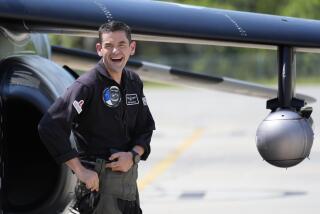NASA taps Boeing, SpaceX, Sierra Nevada to develop new spacecraft
On a cloudless morning, NASA Administrator Charles Bolden stood at the Kennedy Space Center in Cape Canaveral, Fla. — where the U.S. dominated human spaceflight for half a century — and revealed plans for the space agency’s next chapter.
On Friday, NASA handed out $1.1 billion in contracts to three companies to privately develop a new generation of spacecraft that could one day ferry astronauts to and from the International Space Station.
Now that the space shuttle fleet has been retired, NASA has no way to travel to the space station other than shelling out $63 million each time one of its astronauts rides on a Russian Soyuz rocket.
“By investing in American companies and American ingenuity, we’re spurring free-market competition to give taxpayers more bang for the buck,” Bolden said during the news conference. “We’re also making important progress toward ending the outsourcing of American aerospace jobs and bringing them right back to Florida and other states all across this country.”
Southern California’s aerospace industry was a major beneficiary of the announcement. Hawthorne-based rocket maker Space Exploration Technologies Corp., or SpaceX, won $440 million from NASA to develop its hardware. And Boeing Co., which develops spacecraft in Huntington Beach and uses rocket engines made by Pratt & Whitney Rocketdyne in Canoga Park, won $460 million.
And $212.5 million went to Sierra Nevada Corp. of Sparks, Nev., which is building a space plane that resembles a miniature space shuttle.
The awards are part of NASA’s Commercial Crew Program, which lays the groundwork for a new reliance on private companies to transport astronauts.
NASA Deputy Administrator Lori Garver, who was visiting Jet Propulsion Laboratory in La Cañada Flintridge in anticipation of Sunday’s Mars rover landing, said the companies have plenty of work ahead.
“We anticipate a lot of exciting things from these companies over the next 21 months,” she said. “NASA is ready to loosen its grip and let these companies take over.”
The overall design of NASA’s previous space-going vehicles and their missions were tightly controlled by the government and contracted to aerospace giants.
This time, Boeing engineers in Huntington Beach and Houston are working on their own to develop a seven-person spaceship, dubbed the Crew Space Transportation-100, that is designed to fly atop a United Launch Alliance Atlas V rocket.
The company, which has built nearly every manned spacecraft in U.S. history, expects the space capsule to be ready for test flights by 2016.
John Elbon, Boeing vice president and general manager of space exploration, said in a teleconference that the company would be celebrating its 100-year anniversary in 2016.
“It will be really sweet to celebrate 100 years as a company with the first flight of CST-100,” he said.
Of the three contract winners, though, SpaceX is the only company to have its new technology proved in space.
In May, SpaceX became the first private company to launch an unmanned spacecraft into orbit and have it dock with the International Space Station. The Dragon capsule was carrying only supplies at the time, but only the world’s most powerful government entities had previously accomplished the technological and financial feat.
In a teleconference, SpaceX Chief Executive Elon Musk said that the Dragon could have carried an astronaut during the mission, but that it still needed “upgrades to take safety to a whole new level.”
SpaceX engineers are designing an abort system for the capsule that would enable astronauts to escape injury if a launch went wrong. The company is also adding more advanced oxygen systems, temperature controls and other life-sustaining instruments.
The Dragon capsule is designed to carry seven astronauts. The company is aiming for a manned test flight by 2015.
With about 1,800 employees, SpaceX is a fraction of the size of competitor Boeing, which has 170,000 people across the U.S. and about 70 other countries.
Musk, 41, said he didn’t get much sleep Thursday night because he didn’t know what NASA was going to reveal Friday.
“I was quite keen to see the announcement made this morning,” he said.
More to Read
Inside the business of entertainment
The Wide Shot brings you news, analysis and insights on everything from streaming wars to production — and what it all means for the future.
You may occasionally receive promotional content from the Los Angeles Times.











